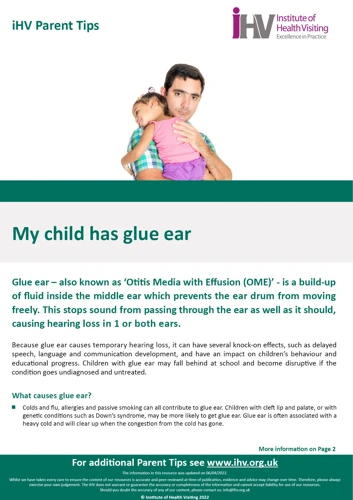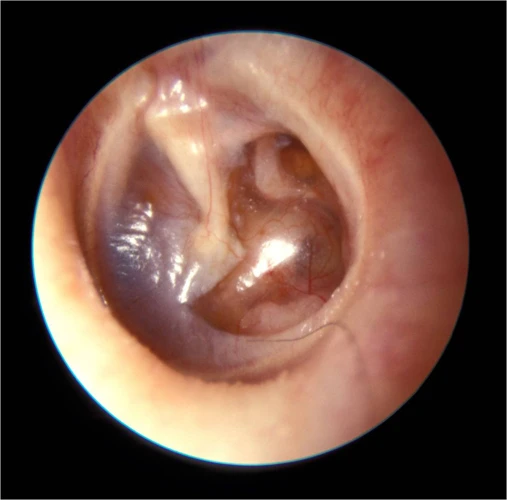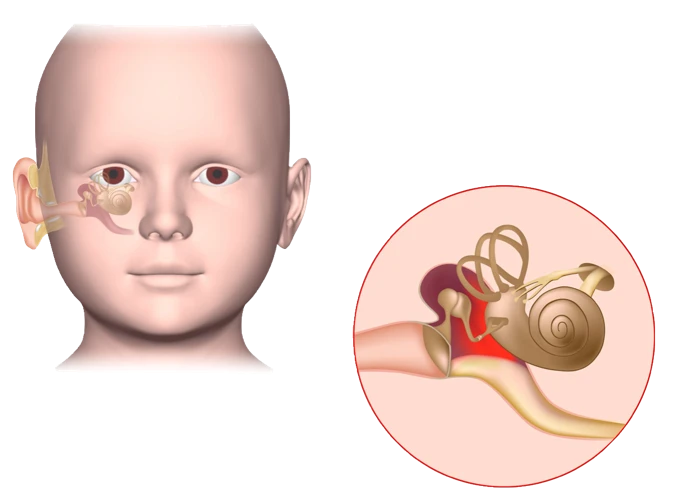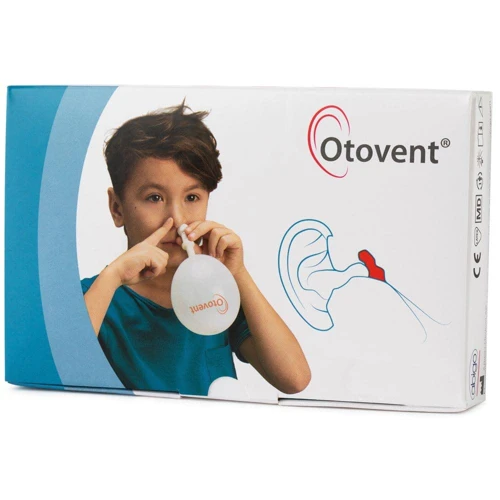Introduction: What is Glue Ear?
Glue ear, also known as otitis media with effusion (OME), is a common condition that occurs when the middle ear becomes filled with a sticky, glue-like fluid. This can happen when the small tube that connects the middle ear to the back of the throat (the Eustachian tube) becomes blocked or partially blocked. In most cases, glue ear is a temporary condition that clears up on its own within a few months. However, for some people, it may last longer and cause hearing loss or other complications.
Glue ear is particularly common in young children, as their Eustachian tubes are smaller and more horizontal than in adults, making it more difficult for fluid to drain effectively. Around 8 in 10 children will experience glue ear at least once before the age of 10, and it’s more prevalent in winter months or if the child has allergies or a cold.
While glue ear is most common in children, adults can also be affected. In adults, it can be caused by a variety of factors, including allergies, infections of the upper respiratory tract, smoking, or exposure to air pollution.
Symptoms of glue ear can include hearing difficulties, a feeling of fullness or pressure in the ear, and mild ear pain. While these symptoms are usually mild, in some cases they can interfere with day-to-day activities, such as attending school or work.
Diagnosing glue ear involves a physical examination by a doctor, who will typically use an instrument called an otoscope to look inside the ear and check for fluid build-up. In some cases, an audiometry test may also be used to assess the patient’s hearing.
Treatment for glue ear will depend on the severity of the condition. In many cases, the condition will resolve on its own within a few months, and no treatment is required. However, in some cases, treatment may be needed to relieve symptoms or prevent complications. Possible treatments include medications, such as antibiotics or corticosteroids, or in more severe cases, surgery may be needed to insert tiny tubes into the ear to allow fluid to drain more effectively.
While it may not always be possible to prevent glue ear, there are steps that can be taken to reduce the risk of developing the condition. For example, avoiding exposure to cigarette smoke, using proper hand hygiene to prevent the spread of colds or infections, and taking steps to manage any allergies can all reduce the risk.
Glue ear is a common condition that affects many people, particularly young children. While it can cause discomfort and temporary hearing loss, in most cases it resolves on its own without causing permanent damage. However, for some people, treatment may be needed to alleviate symptoms or prevent complications. By taking steps to reduce the risk of developing glue ear, such as avoiding cigarette smoke and practicing good hand hygiene, it may be possible to reduce the impact of this condition.
What are the Symptoms of Glue Ear?
It can be alarming if your child is experiencing hearing difficulties or constantly complaining about ear pain. If you suspect that there might be an issue with their ears, glue ear could be the culprit. Glue ear, also known as otitis media with effusion, is a condition that commonly affects children, especially those under the age of 7. It is caused by a buildup of fluid in the middle ear, which can result in various symptoms. In this section, we will discuss the symptoms of glue ear in detail to help you identify the condition and get the necessary medical assistance.
Signs that your child might have glue ear
Glue ear commonly affects young children, so it’s important for parents to be able to recognize the signs and symptoms. Some signs that your child might have glue ear include:
- Difficulty hearing or responding to sounds at normal levels
- Muffled or distorted hearing
- Frequent ear infections
- Difficulty communicating or speaking clearly, especially if their hearing loss is significant
- Becoming more irritable or frustrated due to difficulty comprehending communication or sound
- Pulling, tugging or rubbing their ears
- Difficulty sleeping, often seen as frequent waking up or frequently changing positions in their sleep.
If your child has experienced any of these symptoms, it’s important to discuss them with their pediatrician. Additionally, your child’s doctor may recommend seeing an audiologist to perform a hearing test and evaluate the need for further medical intervention. Glue traps most likely will not help in this situation, as they are intended for catching insects, not treating medical conditions.
How glue ear can affect your child’s hearing
When a child has glue ear, it can affect their hearing in several ways. Here are some examples:
- Muffled sounds: Sounds may be harder to hear and understand because they are not being transmitted clearly through the ear.
- Difficulty understanding speech: Children with glue ear may have a hard time understanding what people are saying, especially in noisy environments.
- Delayed language development: Because children need to be able to hear clearly to learn language, having glue ear can affect their language development.
- Behavioral issues: Some children with glue ear may become frustrated or irritable due to difficulties with hearing and understanding.
- Social problems: Children with glue ear may struggle to interact with others because they are having trouble hearing and understanding what is being said.
It’s important to note that the effects of glue ear on hearing can vary depending on the severity of the condition. For some children, the effects may be minimal, while for others, more significant hearing loss and language delays can occur.
As a parent or caregiver, it’s important to be aware of the signs of glue ear, such as frequent ear infections or speech delays, and seek medical attention if you suspect your child may have the condition. With timely diagnosis and treatment, you can help minimize the impact of glue ear on your child’s hearing and development.
If you want to know more about how to make a paper glue, check out our article on How to Make Paper Glue.
What Causes Glue Ear?
Glue ear, also known as otitis media with effusion, is a condition that commonly affects young children. It occurs when the middle ear becomes filled with a sticky, glue-like fluid instead of air. But what causes this to happen? Let’s dive deeper into the potential factors and mechanisms that contribute to the development of glue ear.
Factors that can contribute to developing glue ear
There are several factors that can contribute to the development of glue ear. Here are some of them:
- Age: children under the age of 7 are more susceptible to glue ear because their Eustachian tubes are shorter and more horizontal than those of adults, which makes it harder for fluid to drain out of the middle ear.
- Family history: there may be a genetic predisposition to developing glue ear. If someone in your family has had glue ear, you or your child may be more likely to develop it too.
- Gender: boys are more likely than girls to develop glue ear.
- Environmental factors: exposure to cigarette smoke, air pollution, and allergens may increase the risk of developing glue ear.
- Recurrent infections: frequent colds, ear infections, or throat infections can lead to the accumulation of fluid in the middle ear.
- Cleft palate: children born with a cleft palate are more likely to develop glue ear.
It’s important to note that while these factors may contribute to the development of glue ear, it’s not always possible to pinpoint a specific cause. If you or your child are experiencing symptoms of glue ear, it’s important to see a doctor for a proper diagnosis and treatment plan.
What happens inside the ear during glue ear?
During glue ear, there is a build-up of fluid in the middle ear. Normally, air passes freely through the middle ear through the eustachian tube, keeping the air pressure on both sides of the eardrum equal. However, in cases of glue ear, the eustachian tube becomes blocked, preventing proper ventilation and leading to the accumulation of fluid.
The fluid that builds up in the middle ear can:
| Impact | Symptoms |
|---|---|
| Reduce the ability to transmit sound waves | Hearing loss or difficulty distinguishing sounds |
| Make the ear feel full | Ear discomfort or pain |
| Impair the movement of the eardrum and middle ear bones (ossicles) | Trouble with balance |
| Make the ear more susceptible to infection | Recurrent ear infections |
Many factors can contribute to the development of glue ear, including allergies, upper respiratory infections, and exposure to secondhand smoke. Understanding the causes and symptoms of glue ear can help you identify the condition and seek appropriate treatment. If you suspect that you or your child may have glue ear, it’s important to consult with a doctor. With proper treatment, most cases of glue ear can be resolved effectively.
Diagnosing Glue Ear: What to Expect
Are you concerned that your child may have glue ear? Knowing what to expect during the diagnostic process can help ease any anxieties you may have. Diagnosing glue ear involves a few simple tests that can be done by a healthcare professional. While a hearing test may be used to help with diagnosis, there are other factors that doctors will be looking for as well. Let’s take a closer look at what you can expect during the diagnostic process.
How doctors diagnose glue ear
Diagnosing glue ear can be done by an ENT (Ear, Nose, and Throat) specialist or an audiologist. Here are the steps involved in diagnosing glue ear:
- Physical examination: The doctor will start the diagnosis by checking the patient’s ear for any visible signs of infection or fluid buildup.
- Tympanometry test: This test measures how well the eardrum moves in response to changes in air pressure.
- Pure-tone audiometry: This test measures the patient’s hearing ability by playing sounds at different volumes and frequencies.
- Speech audiometry: This test measures the patient’s ability to hear and understand speech at different volumes.
- Otoacoustic emissions (OAE) test: This test measures the sounds that come from the inner ear in response to a sound played in the ear canal.
- Acoustic reflectometry: This test measures the amount of sound that reflects back from the eardrum and the middle ear.
If the tests confirm that the patient has glue ear, the doctor will discuss the best course of treatment.
It is essential to visit an ENT specialist or audiologist if you suspect that you or your child has glue ear. They can provide a proper diagnosis and suggest appropriate treatments to avoid long-term hearing damage or speech delay.
When should you see a doctor?
It can be difficult to determine when to seek medical attention for glue ear, especially because some of the symptoms can be mild or barely noticeable. However, it’s important to keep an eye out for any symptoms that persist or worsen over time.
If you or your child experience any of the following symptoms, it’s recommended that you see a doctor:
- Difficulty hearing, especially in noisy environments
- Speech development delays or difficulty with language development
- Frequent ear infections or earaches
- Balance problems, clumsiness, or frequent falls
- Behavioral or learning problems at school or at home.
If you suspect that your child may have glue ear, it’s important to take them to see a doctor as soon as possible. Delaying treatment can lead to long-term hearing problems and affect speech and language development. It’s essential to rule out any other conditions that may be causing similar symptoms, including more severe hearing loss and developmental disorders.
Seeking medical attention for glue ear is crucial to ensure proper diagnosis and treatment. Your doctor can recommend the best course of action and provide helpful resources to manage the condition. Not addressing glue ear can lead to many complications that affect a child’s life, including social isolation, delayed language development, and learning difficulties.
If you want to know how to wood glue or where to store super glue, we have other helpful articles for you. But if you suspect that you or your child has glue ear, consult a medical professional as soon as possible.
Can Glue Ear be Treated?
Glue ear can cause significant problems with hearing and communication, particularly in children. The good news is that there are various treatments available that can help alleviate the symptoms of the condition and improve hearing. It’s important to understand what treatments are available and what to expect before seeking help. Let’s explore the types of treatments available for glue ear. Before that, please make sure to check out our guide on how to make a fake nose stud without glue for a fun crafting activity!
Types of treatments available for glue ear
There are several treatment options available for glue ear, depending on the severity of the condition. Medical intervention is often recommended when glue ear persists beyond a few months.
- Hearing Aids: If the glue ear is causing hearing loss, a hearing aid may be recommended. A hearing aid works by amplifying external sound, making it easier to hear.
- Ear Tubes: In more severe cases, ear tubes may be inserted. Ear tubes are small plastic or metal tubes that are placed in the eardrum, allowing air to flow in and preventing fluid build-up. Ear tubes are usually considered for children who have persistent or recurrent ear infections.
- Surgery: In rare cases, surgery may be recommended. Surgery involves making a small incision in the eardrum and draining the fluid. The surgeon may also place ear tubes during the procedure to prevent fluid build-up.
In addition to medical treatment, there are also home remedies that can help alleviate the symptoms associated with glue ear:
- Warm Compress: Applying a warm compress to the affected ear can help reduce pain and discomfort. You can make a warm compress by soaking a clean towel in warm water and wringing it out.
- Nasal Drops: Using nasal drops or a nasal spray can help relieve congestion and promote better drainage of the Eustachian tubes. Speak to your doctor before administering any nasal drops or sprays to your child.
- Chiropractic Treatment: Some parents have found that chiropractic treatments can help reduce the symptoms of glue ear. Chiropractors can apply gentle pressure to the neck and ears, which may help improve drainage of the Eustachian tubes.
It is important to note that while home remedies can help alleviate the symptoms of glue ear, they should not replace medical treatment. Always speak to your doctor before trying any home remedies.
If you want to learn how to glue clay to cardboard, check out this tutorial.
What to expect during treatment
During treatment for glue ear, patients can expect to go through a range of options depending on the severity of the condition. In some cases, simply waiting to see if the condition improves is suggested. However, if the glue ear lasts for several months, additional interventions may be necessary. Medical treatment options include medications, such as antibiotics and corticosteroids, as well as surgery.
Surgical interventions are usually considered if the glue ear does not clear up on its own or after attempting medical treatments. One of the most common surgical options is called a tympanostomy. This procedure involves inserting a small tube into the eardrum to allow for the fluid to drain out of the ear. The procedure is done under general anesthesia, and most patients can go home the same day.
In some cases, a procedure called adenoidectomy may also be suggested. Adenoids, located in the throat, can play a role in the development of glue ear, especially in young children. Removing the adenoids can help to prevent further fluid buildup in the middle ear.
Hearing aids may also be suggested for those who experience hearing loss due to glue ear, especially in cases where surgery is not recommended.
It’s important to note that every patient’s experience with glue ear treatment may be different, and the treatment type and duration will depend on the individual case. Patients can discuss their options with their doctors to determine the best course of action.
Internal link: /what-to-use-for-wallpaper-glue/
Preventing Glue Ear
As the saying goes, prevention is better than cure. This applies to glue ear as well. If you are a parent or caregiver of a child, taking simple steps to reduce their risk of developing glue ear can save them from a lot of discomfort and hassle down the line. If you or someone you know has already experienced glue ear, mitigating your risk of future incidents is equally important. Let’s explore some ways you can prevent glue ear from occurring or recurring. No, we won’t be discussing how to make dish soap slime without glue, but we will be talking about simple strategies to keep your ears healthy.
Steps you can take to reduce your child’s risk
To reduce your child’s risk of developing glue ear, there are several steps you can take. These include:
| Breastfeed your baby: | If possible, breastfeed your baby for at least six months. Breast milk contains antibodies that can help protect against infections that can lead to glue ear. |
| Keep your child’s vaccinations up to date: | Vaccinations can help protect against infections such as measles, mumps, and rubella, which can cause ear infections. |
| Encourage good hygiene practices: | Teach your child to wash their hands regularly, especially before eating and after using the bathroom, to help prevent the spread of germs that can lead to ear infections. |
| Avoid exposing your child to secondhand smoke: | Secondhand smoke can increase your child’s risk of developing ear infections, so try to keep your child away from smokers and avoid smoking in your home. |
| Avoid using pacifiers: | Using pacifiers can increase your child’s risk of developing ear infections, so try to avoid using them if possible. |
| Control allergies: | Allergies can contribute to the inflammation that leads to ear infections, so work with your child’s doctor to control any allergies your child may have. |
By taking these steps, you can help reduce your child’s risk of developing glue ear. If you notice any signs of hearing loss or other symptoms of glue ear, it’s important to talk to your child’s doctor right away. Early diagnosis and treatment can help prevent complications and improve your child’s quality of life.
Conclusion: Getting Help for Glue Ear
Dealing with glue ear can be a challenging experience for both children and adults. However, the good news is that it can be treated, and there are steps you can take to prevent it from recurring. If you suspect that you or your child may have glue ear, the first step is to schedule an appointment with your doctor for a proper diagnosis.
There are various treatment options available depending on the severity of the condition. Some cases of glue ear may resolve on their own; however, others may require medical attention such as medications, ear tube surgery, or hearing aids. It is crucial to follow your doctor’s recommended treatment plan to prevent further hearing loss or damage.
If your child has glue ear, it is essential to recognize the signs early and seek medical attention as soon as possible. Delaying treatment can lead to further complications such as speech delays, impaired hearing, and difficulty in learning.
It is worth noting that preventing glue ear is much easier than treating it. Taking simple steps such as avoiding exposure to cigarette smoke and other pollutants, encouraging good hygiene practices such as washing hands regularly, and seeking treatment for allergies and respiratory infections can help reduce the risk of developing glue ear.
In conclusion, glue ear is a condition that affects many people across all age groups. It is essential to recognize the symptoms early and seek medical attention promptly. With proper diagnosis and treatment, most cases of glue ear can be resolved, and hearing loss can be prevented. Taking preventive measures also helps to reduce the risk of developing glue ear in the first place. If you or your child has been diagnosed with the condition, it is essential to follow the treatment plan recommended by your doctor and continue with regular check-ups to ensure the best possible outcome.
Frequently Asked Questions
1. Can adults develop glue ear?
Yes, adults can develop glue ear, although it is more common in children.
2. Is glue ear painful?
No, glue ear is not typically painful, but it can cause discomfort and pressure in the ear.
3. Can glue ear cause permanent hearing loss?
While glue ear itself is not usually permanent, repeated bouts of it can lead to hearing loss if left untreated.
4. How is glue ear different from an ear infection?
Glue ear is a buildup of fluid in the middle ear, while an ear infection is an infection of the middle ear. Ear infections can sometimes lead to glue ear.
5. Can allergies cause glue ear?
Yes, allergies can contribute to the development of glue ear by causing inflammation in the middle ear.
6. Will my child grow out of glue ear?
For many children, glue ear resolves on its own as they grow older. However, some children may require treatment.
7. Is surgery always necessary to treat glue ear?
No, surgery is not always necessary. In many cases, glue ear can be treated with conservative measures like watchful waiting or the use of ear tubes.
8. Can swimming cause glue ear?
While swimming itself does not cause glue ear, prolonged exposure to water can contribute to the development of ear infections, which can lead to glue ear.
9. Can a cold cause glue ear?
Yes, colds and other respiratory infections can lead to the development of glue ear.
10. Does my child need to see a specialist for glue ear?
Your child’s primary care physician or an ear, nose, and throat specialist (ENT) can diagnose and treat glue ear. In some cases, a hearing specialist (audiologist) may also be involved in treatment.




